
Memelab was originally a group of memeticists based in Bristol who met together regularly to talk about memes, evolution, human nature, and other related topics. We usually met in Sue Blackmore’s garden, about once a month or so from early 1998. In the winter we squashed into the turret on top of the house. We stopped for a while in 2001/2002 and started again in 2006 with the addition of Alan Winfield and Owen Holland. Although we carried out only a few experiments as a group, the discussions we had contributed to many of our publications on memetics.

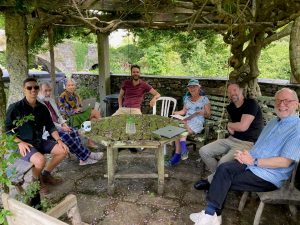
Memelab is back after a long break and what a great one this was – not only terrific discussions but swimming in the cold river (14 C), progressive Ping-Pong in near darkness, exercises led by Emily, and even a trip to the beach. There were 7 of us ranging across engineering and robotics, psychology, cognitive science, history and more: Alan Winfield, Andoni Sergiou, Emily Troscianko, James Carney, Owen Holland, and Steije Hofhuis. My husband Adam Hart-Davis and Emily’s partner, James Anderson, cooked wonderful food for us all and joined in some of the sessions. As ever – no lectures, just each person leading an hour’s discussion on their chosen topic.
I set off the discussion the first evening. With the current furore over fears of uncontrollable AI, I described my ideas of a third replicator and why this means that AI is evolving for its own sake, not ours. This led to ideas about LLMs, tremes selecting machine-generated data, sources of variation, competition for resources, fake people, and the possibility of us intervening in any of this. Next morning, Owen followed up on these ideas, talking about attention, generative pretrained transformers, how LLMs really work – they are curated and do not learn, and the myths surrounding them. He asked the LLM ‘Claud 2’ a question about memes and tremes. ‘Intriguing’ said Claud (along with a fair account of the topic) and this became a joke buzz-word for us.
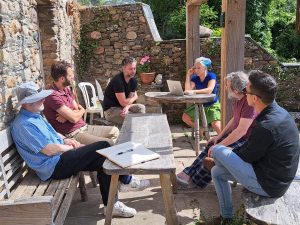
Emily has long worked with anorexia, trying to understand why people cling to their disordered behaviours for so long and many don’t want to recover. Rereading The Meme Machine, she realised that these behaviours benefit only themselves. The anorexia memeplex is a mass of imitable behaviours protected by threats and untestable promises and, also like religions, becomes your identity and makes out you are ‘good’ It is even reinforced by consequences such as OCD and infertility. Others added thoughts on transmissibility, moral content and values, why inpatient treatment increases destructive behaviours, and comparisons with trans phenomena, and social media. Andoni raised a question about niche construction v direct transmission, and we all discussed ways of testing whether it’s useful to think of eating disorders as memeplexes. James followed this up talking more generally about memes and cognitive pathology, using semantic frames to study dementia and other neurodegenerative conditions that can act as different selection environments. Some (including me) knew little or nothing about semantic frames and learnt a lot. We discussed whether they are copied in the way words are, or provide a selective environment without being memes themselves. James described current and future research on SFs and deficiencies in dementia.
Last time (back in 2019) we had only just heard about Hofhuis and Boudry’s work on the Medieval witch persecution memes: this time Steije Hofhuis came all the way from the Netherlands to explain their research and how they concluded that these horrible practices benefitted no one and nothing but themselves. Historians had assumed the persecutions to be intelligently designed e.g. by shrewd clerics, but communities were destroyed, resources exhausted, and everyone suffered. He described the evolving features that increased the spread and power of the practices until they finally died out. We discussed beliefs about the Devil, the effects of printing, the many variants that competed, and how historians did mention ‘immunisation’ or ‘contagion’ but only as figures of speech. We also discussed a favourite topic – why people hate the idea of memes. James described the resistance to change in academia, Andoni the idea of relativism as a meme itself, and Steije remarked that in his career he has been disadvantaged by being infected with the selfish meme meme.

The weather was not bad (for this horribly cold July) and among the sessions we held in the garden was Andoni’s on agency, self, and consciousness. He set this in the context of network theory and percolation thresholds, with examples from the origins of life and brain expansion leading to agency. He talked about highly interconnected brain networks creating the sense of ‘you’ and considered the conditions needed for a memeplex to form – an important question for memetics. We argued about representation, copying, and propagation, and especially agency. Alan maintained that replicators are not agents, I said they are, Owen added the ‘appearance of agency’ and we all ended up arguing vehemently about free will – one topic we will never resolve! We agreed it was ‘intriguing’!
On Sunday morning, Alan spoke about the evolutionary origins of curiosity and artificial creativity. To Dennett’s Tower of Generate and Test, he added Waldarians – a new level that adds curiosity. He argued that Skinnerians cannot be creative, and we ended up exploring the nature of humour and how jokes make you laugh. He compared his robots that can ask ‘What if’ questions to LLMs that are not creative, and cannot experience ‘aha’ moments, asking what is missing from robots now?
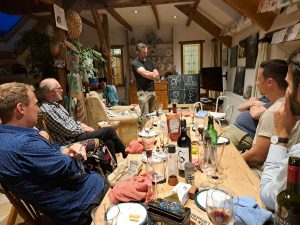
For the ‘Final Reckoning’ session we spent some time wondering where we have got to with memetics in the fifty years since Selfish Gene and twenty-five since Meme Machine. At the last Memelab I was still wondering whether memetics might not be significantly different from conventional (genetic advantage based) cultural evolution theory. Now I am certain that it is – not just different but better for some purposes. We have made recent progress and these discussions showed how. James asked whom we are trying to convince and mentioned the (often ignorant) anti-Dawkins attitudes in cultural studies. Steije said we need more case studies. Andoni offered to set up a website or repository for anything we might like to share and Alan said he owns the domain Memelab.uk.
Emily asked me to talk about the book I’ve been trying to write for more than 2 years, which I was happy to do. Its provisional title is God’s Memes: How religions evolved to exploit us and why we let them. Steije said he’s read most of the Bible and noted its propagation both horizontally and vertically. Andoni mentioned the value of rituals and credibility-enhancing displays, as well as cultural group selection (another controversial topic). He suggested reasons ‘why we let them’ and mentioned gene regulatory networks, and how porous membranes increase evolvability. James discussed social functions, and the crap models people can make when trying to cope with anxiety and unpredictability. I asked about the structure of memeplexes and the tricks they use to protect themselves. I realised that in struggling with this book I have been confusing two objectives. One would mean a book on religion using memetics for explanations, the other a book on memetics using religion as an example. Our discussion helped me to decide that the second is really what I want to do if I can.
increase evolvability. James discussed social functions, and the crap models people can make when trying to cope with anxiety and unpredictability. I asked about the structure of memeplexes and the tricks they use to protect themselves. I realised that in struggling with this book I have been confusing two objectives. One would mean a book on religion using memetics for explanations, the other a book on memetics using religion as an example. Our discussion helped me to decide that the second is really what I want to do if I can.
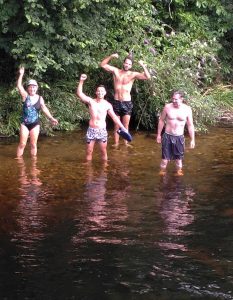
Are we optimistic about the future of memetics?
We took a fun vote and the responses ranged from Alan giving it 4 to James and me 8. Then those of us who did not have to catch early trains went to our nearest beach at Mothecombe and continued arguing while climbing rocks and trying not to get cut off by the tide.
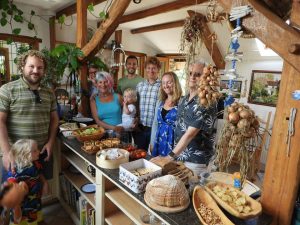
This Memelab, at our house in Devon, took a new approach. My son, Jolyon Troscianko, and his wife Emma Rosenfeld are both biologists working at the Falmouth campus of Exeter University where there is a lively group studying cultural evolution. Two of these researchers were able to come for this weekend, Alex Thornton and Alex Mesoudi. We also had Alan Winfield robotics expert from Bristol, and Richard Dawkins (creator of the term ‘meme’ of course). Jolyon and Emma made meals (that’s our lunch in the photo), as did my husband Adam Hart-Davis.
The main question I wanted to address was this – I asked “Is memetics the same as conventional cultural evolution theory (which is now growing fast), or different? If they are the same, I might as well give up on memetics! And are there testable predictions that would discriminate between them?” After our discussions, I remained happily convinced that the two approaches are different because memetics treats memes as replicators in their own right whereas, almost without exception, cultural evolution theorists do not. We need much more research, but Alex told us about Hofhuis and Boudry’s work on witch trials which suggests ways to find out whether memetics makes different predictions from conventional gene-based theories.
We discussed imitation in other species, whether true imitation is needed for cumulative culture, the possible memetic origins of language, artificial culture in robots, racism and zenophobia, and the possibility of a third replicator, tremes. We shared so many ideas that I think everyone went away having learned a lot and I was greatly encouraged – though the answer to the big question remains elusive.
“After our 2019 meeting, Covid stopped our memelabs but we hope to start again when we feel it is safe to do so.”
Once again we were in Devon with Alan Winfield, Stevie Smith, Pascal Jouxtel, Sylvain Magne, and Paul Marsden. On Friday evening, the Frenchmen, who had never before met each other, cooked a fishy dinner for us all, after we’d all been outside to pull up leeks from the garden.

I began Saturday with a brief account of my talk at the American Atheists’ conference in Memphis (a great choice of city for atheists! Local Christians had a special meeting there to pray for us). I met several ex-Muslins there, including Ayaan Hirsi Ali, and was shocked to meet atheists who could not ‘come out’ as non-believers in their home towns or at work. I talked about the time a hundred or so Muslims walked out of my lecture on memes.
Much of Saturday concerned free speech and its limits. Pascal talked about the Charlie Hebdo killings, the consequent memes and why so many people posted ‘Je suis Charlie’ (I did myself). Alan and Paul said they were firmly ‘pas’ Charlie, interpreting it as about free speech which must have limits, while I interpret it as about the freedom to offend – with limits but important to fight for.
Paul talked about his work with MI6 and the MOD and how, after 9/11, he was asked to write about ways of stopping recruitment for Jihadis. We discussed sex, famous people, humour and other meme hooks, the possibilities of counter-memes, the empowerment of women, and ways of preventing the spread of jihadi memes. We came up with lots of ideas but, as ever, struggled to come up with a uniquely memetic contribution to the debate.
A really fierce game of croquet, with lots of devious strategy, made for a good break from too much thinking and talking.
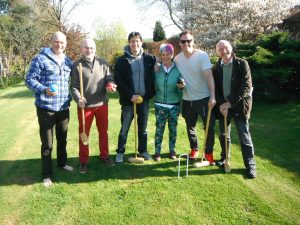
On Sunday Sylvain cooked us all French pancakes before Pascal presented his ideas on memes as codes coming through the senses, arguing that the code is the replicator. There was a great deal of argument about this. Sylvain said he wants something physical as the meme; Stevie said this could be physical when we can read the information in a brain. Alan rejected the code idea, wanting to stick with the ‘unit of cultural transmission’. This all seemed to drag us back into all the old arguments about what or where a meme is when, in my opinion, Dawkins’ original definition is the whole point of memetics – memes are ‘that which is imitated’ or a unit of transmission.
We ended with a brief discussion of Dan Dennett’s ideas about re- and de-Darwinizing which he told us about in 2013. I don’t think any of us understood this properly or could apply the ideas usefully to memetics. After the others left, Alan and I had a long walk on a sunny afternoon, talking about AI. He says people fear the wrong things, things that are exceedingly unlikely, but he does not share my concerns about tremes – that their replicator power threatens any idea we might have that humans can control the future evolution of AI.
This time we all met up at Alan Winfield’s home in Bristol – Alan and me, Rachel Cohen, Martin Farncombe, and Sylvain Magne from France. On the Saturday Martin led a discussion on why some adverts and TV trails fail – active suppression, memory or attentional effects, ‘memetic immunity’ – Alan commented on the importance of forgetting in cultural evolution. He saw a church sign saying “Doubt is the beginning of defeat”!!
Rachel had us copying drawings for her project on lines of transmission in drawing, comparing the effects for stars and scribbles (cf Sperber) and using both ‘copy the drawing’ and ‘copy the instructions for making the drawing’.
I described the wonderful meeting I had been to at the Santa Fe Institute, a week organised by Dan Dennett on the topic of cultural evolution with Rob Boyd, Joe Henrich, and Dan Sperber among others. Only Dan and I defended memetics, and I learned a lot about how dual-inheritance theory differs from memetics and why Sperber thinks memes are not a replicator.
On Sunday, Andrew Atkins on joined us and talked about his thesis on different evolutionary approaches to religion and cognitive science of religion, how hyperactive agency detection leads to concepts of God, and Norenzayan’s ideas about how Big Gods evolved to watch people. He argued that memetics should get rid of its ‘selfish’ label.
Sylvain picked up various objects, asking ‘Where is the meme?’ a familiar question when people want memes to be locatable and cannot accept the original definition of a meme as ‘that which is imitated’. He discussed the selective environment for sounds and their history, and asked is the meme the sound, the idea, the word, the sound waves. Is it a naked meme? I suggested we cannot separate a meme from e.g. a ‘memotype’ unless there is the equivalent of a germ line which there is not for sounds. But Sylvain pointed to phone tunes based on digital copying for which there is a germ line. Are they temes? No.
Over coffee we argued about taste memes and ‘ways of making coffee’ memes. Then we started tying shoelaces and I demonstrated a reef know v granny knot. Andrew said these are not memes. Alan said there are 2 memes – the knot and the instructions for tying it. Sylvain is not happy with ‘what is copied’ arguing that the knot is the phemotype and tying it is the replicator. So we came back to the absence of a germline in naked memes.
Alan showed us a video of his Ethical Robot, dithering in trying to ‘rescue’ two other tiny robots. These are very simple, small robots with no memory. He talked about the unexpected consequences of using real (if very simple) robots compared with simulations, and the importance of forgetting in cultural evolution.
In my diary I wrote afterwards that “I was left wondering about the important transitions. 1. There’s the appearance of a germ line, only then is there a replicator analogous to a gene. 2. Temes/tremes escaping from human control. Which deserves the new name?” (Writing up these notes in 2021 I am interested to see that I had not then decided that we should consider information to be a ‘third replicator’ only when all three processes, copy, vary, and select, are carried out by human-made machines.)
We met at Sue and Adam’s house in Devon again, and on the first evening Pascal cooked a delicious African dish of lamb, from lambs that had once been in our field. And afterwards he taught us to play the brilliant game of “Evolutionary” – a kind of Pictionary-type game that gave us enormous fun (and fury).

If I remember correctly – one person goes out of the room while everyone else chooses a target idea or object. The chosen player comes back in and draws four different sketches on the board. Everyone else discusses which of the four is least like the target. That drawing is then rubbed out and the player draws something else. The player who needs the fewest drawings to get the answer is the winner. I seem to remember that Jolyon got it right in just 2 goes while the rest of us were taking 5 or even 10 tries. Just luck!
Once everyone else had arrived on Saturday, we tackled some huge topics. Alan asked what is the actual energy cost of creating a human and, considering sun capture, our power generation and energy available over 4.5 billion years, concluded “It’s colossal”!
Stevie asked “Is sustainability still possible?” and whether we can find ways to increase empathy before it’s too late. He described the online space game he is developing to measure and encourage meme-cooperation.
Jolyon explored ways of measuring the success of memes, considering fidelity, population size, different measures of fitness, and pondered possible equivalents of r and k-selection, or punctuated equilibrium for memes. Martin said Joly’s equation was similar to Heylighen’s, leading to

much discussion including about the importance, or not, of stability.
Emma showed us a new Internet meme – a craze for taking selfies without make-up that was co-opted by Cancer Research to get people to give £3, leading to a discussion of virtue-signalling, honest signals for altruism,
Martin discussed the stability of national cultures and how they are passed on, with many slides showing the differences between multicultural business teams and how the differences are often ignored. He asked how the notion of niches applies in culture. We discussed Sterelney’s ideas about cultural and informational niche construction, and Martin said (apropos Boyd and Richerson’s claim that memes are not replicators) “We know memes are replicators because they can jump from niche to niche”.
Marina presented some ideas for a talk she is giving on evolutionary psychology. She thinks that memetics suffers because top people in other disciplines think they understand it when they don’t.
Pascal talked about organisations as living things. He presented his PhD work to us, considering the definition of a meme and questioning what allows us to say that any memes are the same or different.
I was nervous speaking on Sunday morning because I was preparing for a seminar at the Santa Fe Institute (read transcripts of this Cultural Evolution Workshop). Dan Dennett was the organiser and had asked each of us to present the ideas of another. I was to do Nicolas Claidiere which involved more of the difficult Godfrey-Smith diagrams we had all discussed before. But this went fine and people suggested we have another Memelab soon where I could report back on the event – hence our next meeting.
We had proper Devon cream teas and a great roast dinner cooked by Jolyon and Emma. Thanks to them and to Adam for looking after us all so well. And we had walks in the fields and woods nearby, as well as up on Dartmoor on the final day.
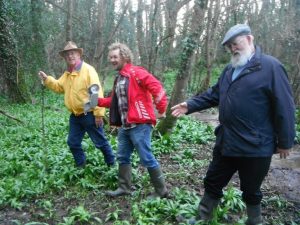
In 2013 we welcomed Dan Dennett, Larry Bull, Stevie Smith, Jonnie Hughes, Alan Winfield and Marina Strinkovsky, Jolyon and Emma (who looked after us and cooked). It was pouring with rain and cold!
Dan and his wife, Susan, arrived on Friday and we had a long tea with Dan saying words are the most important memes, they are virtual machines and like Java Aplets can run on any brain already loaded with e.g. English. Neurons have been tamed, like feral animals that revert to wild-type.
Over breakfast the next morning Dan and I had an intense and very useful talk about free will. We have always disagreed on this. I think Freedom Evolves should be called Choice Evolves because I say our will is not free and can never be, even if we evolve to have more abilities and choices. From this significant conversation I came to conclude that Dan rejects ideas like mine (and e.g. Sam Harris) because he’s so afraid of the consequences of people not believing in it. I continue to disagree.
All the others arrived later on Saturday.
Dan gave a long talk based on the evolutionary diagrams of Peter Godfrey-Smith. I think we all found this hard to understand and struggled to relate the ideas clearly to memetics.
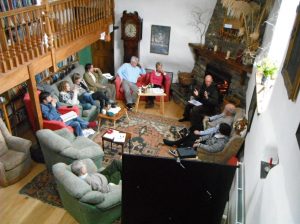
Jonnie talked about his book On the Origin of Tepees, showing how designs evolved by imitation, variation and selection.
I showed a collection of recent viral Internet memes. We nearly got together to make our own Haarlem Shake video but Richard was horrified by the idea and somehow we never managed it. We all discussed reasons why these memes did so well.
In the evening we played a game that Stevie has invented as part of his work to expand the circle of compassion as the world faces crises. Then later, just Jolyon, Dan and me survived to play a word game Dan taught us – ‘Frigate Bird’ in which you steal other people’s letters. (Dan and Susan had once taught this game to Adam and me when we were all on a ‘Skeptics’ Cruise’ together, Dan and me as lecturers – a fearsome game that I could never master.)
Sunday included Larry’s session, explaining his latest computer simulations and models using two replicators of different speeds. The fall in fitness of the first replicator is very fast as the second speeds up, providing evidence to support my idea (in Meme Machine) that memetic drive led to increased brain size. Both Dan and Richard seemed impressed by this work.
The final session was Stevie on memes and self, why the rational self is only the tip of the iceberg and why we are reluctant to dig deeper. This interested me as both Stevie and I are long-time Zen meditators. Joly suggested the self evolves because of a bottleneck – Dan says that’s your mouth. We all got into arguments on free will and responsibility again. Dan saying the boundary between ‘me’ and my body is there for a good reason. I got the impression that few, if any, of us agreed with Dan about free will. Jonnie thought a paradigm shift is imminent.
Just a few of us remained after lunch for a walk up on Dartmoor (only a few miles from here) discussing the evolution of layers of hardware and software – and enjoying the wonderful views now the rain had stopped.
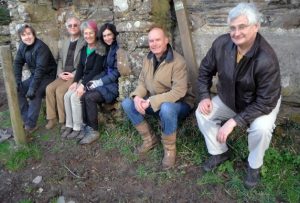
The first memelab at Sue and Adam’s house in Devon. As people live far away, memelabs have taken on a new life as whole weekend events with everyone staying the night. This year we welcomed: Richard Dawkins, Rachel Cohen, Jonnie Hughes, Daniel Riley, Alan Winfield, Steven Smith and Martin Farncombe.
Rachel explained her ‘Chinese Whispers’ drawing project and we all had a go at copying drawings. We discussed whether there can be any equivalent of a germ line for memetics and if so how experiments like this could be designed to test it. Richard suggested an operational test on the drawings would be to see if people could reproduce the actual sequence of copying.
Steve explained how the concept of ‘sustainable development’ has deteriorated. Can memetics help us find a way to get global agreement in time to avoid planetary disaster? Richard suggested the memetic idea of getting ‘sacrificing self for the future’ to go viral. Sue explained how her attempt to give up flying for ever came to a sad end after 5 years ‘I’m giving up on sacrifice’. Most agreed ‘We’re fucked’.
Richard pursued the separation between germ line and phenotype. Origami is a good example (as in the Foreword to Meme Machine. It is self-normalising – as are words of a known language. I would say it entails ‘copy-the instructions’ not ‘copy-the-product’. So we all learned how to make an origami junk. Martin and Daniel made mutants. I still have mine. With drinks in the evening we tried out Daniel’s Twister game, imitating his positions.
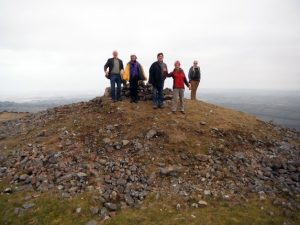
On Sunday, Alan talked about the emergence of artificial culture in societies of robots, as a way of exploring the mechanisms of culture creation. His robots watch each other and imitate movements i.e. embodied imitation spreads as memes.
Martin talked about how rumours go viral, using Markov chains to model beliefs such as WMDs in Iraq. He showed the rise, fall and variations of the viral photos of ‘Tigers on Primrose Hill’ and how they all began from a hoax.
Finally, I talked about my developing ideas on temes. I’d been invited to write a short TED book on Genes, Memes and Temes (15k words). Richard suggested I should call the third replicator ‘thremes’. We discussed the minimum conditions needed for a third replicator.
Sue Blackmore, Alan Winfield, Martin Farncombe, Daniel Riley and Jonnie Hughes.
Since Sue moved to Devon in 2008, memelabs had to change. In 2011 Alan Winfield invited us to his house where we were joined by Jonnie Hughes with his new book On The Origin of Tepees, and my student, Daniel whose project is correlating creativity with imitation ability – measuring that by getting people to copy positions on a twister mat.
We discussed the ever-present question of why there is still no science of memetics. We need to find a use for it!
Quote of the day (Jonnie) “We are at the Aristotle stage”.
Alan said back pain is memetically transmitted! Is this so?
Alan showed us the latest robot video and ‘memographs’ showing the evolution of simple ‘dances’ copied by one robot from another – very exciting! We discussed types of imitation, diversity and stability in the meme pool, and the potential effects of rewards for the robots. What would rewards be? Energy? Being imitated? What different would this make?
This time we were joined by Andrew’s supervisor, philosopher of science, Samir Okasha. We talked about his work on levels of selection, which is so relevant to speculations about memes, and about gene-culture co-evolution. We discussed Peter Godfrey-Smith’s ideas on Darwinian populations and natural selection, and intragenomic conflict by analogy with memes. Someone mentioned that there is a Creationist Zoo in Bristol, which I hadn’t realised. We decided we must have a Memelab outing to visit it (but somehow we never managed that!). This led to a discussion about when it’s worth arguing with idiots.
This time we were joined by student Andrew Atkinson, who shared notes on his proposal for a PhD on religious memes. He described his Irish background, religious upbringing, and reading The God Delusion leading to his current plans. We discussed the familiar problem of using analogies, including religions as viruses. Alan related these ideas to cladistics, and family trees, or bushes, of meme evolution.
Is the C of E falling apart? If so is it becoming less relevant, losing power? Is anything like that happening in Islam? The Roman Empire had many different beliefs and tolerance of others – ripe to be infected by an intolerant religion based on threats and promises? Does the God virus have properties other memeplexes don’t have, can you get rid of old memes, and where do they go?
Above all we need empirical research. We discussed the Beethoven Experiment, Alan’s robots and Larry’s abstract models.

We discussed Alan Winfield’s latest robots and the start of the Artificial Culture Project. These little robots are true teme machines because (a) they operate outside of human control and (b) they have all three – heredity, variation and selection. He emphasised that in this system selection occurs by necessity; it’s not programmed in.

Alan, Marios and Stef, in our garden in Bristol. Looks like we were eating the last of my birthday cake. Marios, with a degree in AI Engineering, said he wanted to shift into memetics. Stef was more interested in philosophy and music. We played about with musical memes and talked about the Beethoven experiment that Larry and I were doing.
I described my alternative to the Drake Equation, my speculations arising out of the idea of the third replicator, inspired by being invited to write a chapter for a book on culture in the cosmos! (this later led to my TED lecture). Ali – add link to TED lecture.
Alan talked about his idea of creating culture in a very simple system – an artificial culture – building on the possibility of imitation in simple robots.
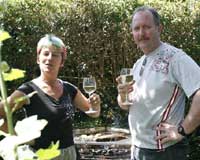
John Wilkins visited from Australia
John Wilkins visited from Australia to discuss speciation, natural selection and how well the meme-gene analogy can be made to work. We also had a fine barbecue. He seemed seriously worried that our barbecue was right by the hedge and would set fire to it. I had to explain about our perpetually rainy English summers.
Sue, Larry Bull, Alan Winfield, Dave Rose, Owen Holland in our garden in Bristol. We discussed Boyd and Richerson’s work and why they don’t want to accept memes as a new replicator, and drew scribbly diagrams showing the limited space in which memes are beneficial to genes.
We talked about imitation (sexy idea) v memes (not), why imitation is not equivalent to replication because there are many other mechanisms, and Owen wanted to move away from Larry’s abstractions to discussing process.
Larry explored ways of modelling when there is a benefit to genes in having memes as well. Brain as cultural immune system. The problems of fidelity.
We talked about protomemes, whether stone tools were memes and when true imitation may have arisen. Larry described our brains as a cultural immune system and wondered when too many memes would become detrimental. There could be two strategies and maybe Neanderthals took alternative route. I think we drank a bit and my notes say, “Ride your memestorm!”.
Spiral Dynamics uses the term ‘meme’ but not in its original meaning – causing much confusion. In May 2006 Chris Cowan and Natasha Todorovic (right), who were teaching a course on Spiral Dynamics, came to visit and explore the differences.
Eric de Rochefort and Pascal Jouxtel (left), who attended the course, also visited memelab. Note the new animal !
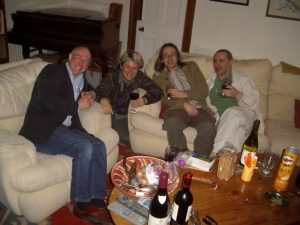
Over lunch time I went, with others, to visit Alan’s Bristol Robotics Lab and see his little robots and we had a great talk about artificial consciousness. Then in the evening we had Memelab with Owen, Larry and Alan. Larry talked about his latest ideas for modelling two replicators, making analogies with immune systems, and we discussed how this might explain the big human brain and Neanderthals’ brains. After a break , Alan explained his ideas on the possible emergence of imitation in robot swarms.
 Memelab 2003 (October)
Memelab 2003 (October)We were joined by Pascal Jouxtel in Bristol.
Here he is making meme soup in Sue Blackmore’s kitchen. Is there a memotype/phenotype distinction here?
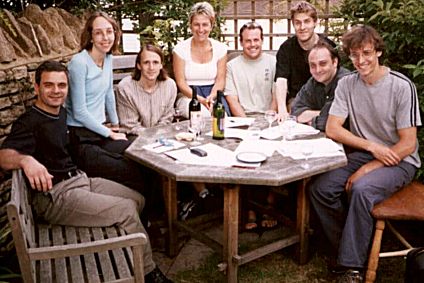
We were joined by a group from Cambridge who climbed trees and played table tennis as well as exchanging memes.
Dr Derek Gatherer – Then Lecturer in Molecular Genetics in the School of Biomolecular Sciences, Liverpool John Moores University.
Rob Clewley – then at Bristol University, now at Center for Biodynamics, Boston University,